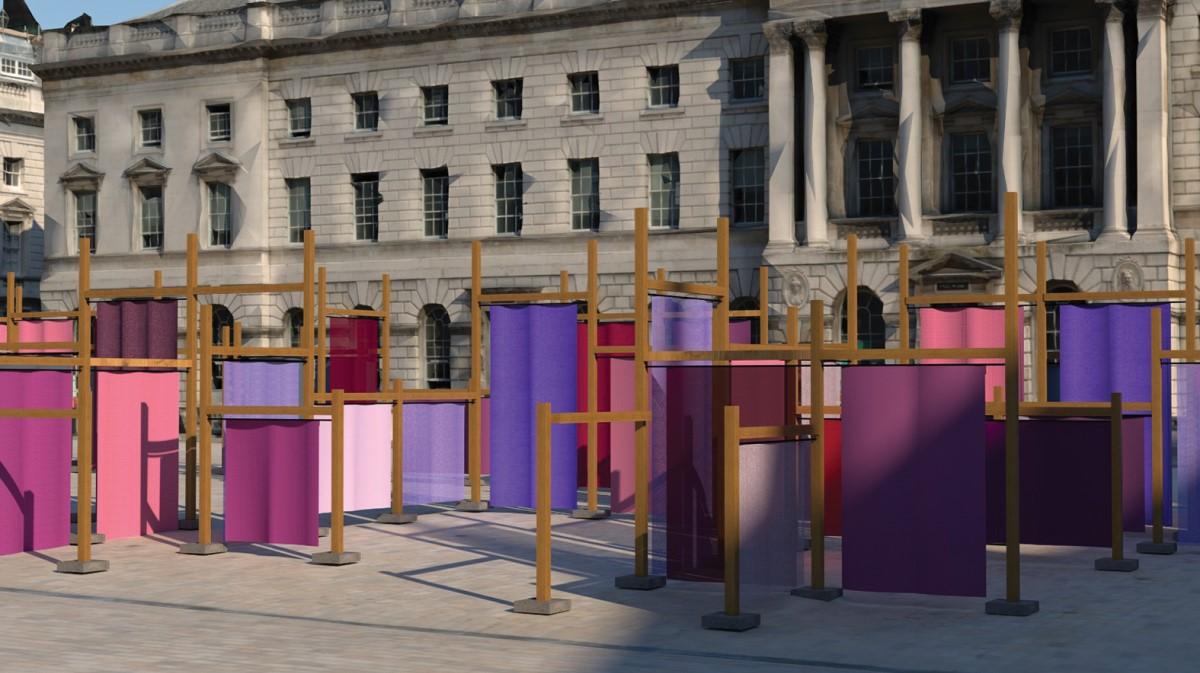Matthew Joseph Casha
- As creative lead of the project, how does it feel to be the first team to represent Malta at the London Design Biennale?
This opportunity came with a sense of honour and great responsibility. As the first team representing Malta, it provided us with the chance to set a high standard and create a lasting impression. We created a unique and unforgettable experience that captures the essence of Maltese culture and design, leaving a lasting impact on visitors and fellow designers. Overall, being the creative lead for this project is an incredible honour. It gave us the opportunity to shine a spotlight on Malta’s creative potential, foster cultural exchange, and contribute to the global design landscape and part of London Design Biennale’s Global Game. I’m thrilled to be part of this great team of artists and proud to have left our mark at the London Design Biennale.
- How the concept for the entire project born, and how did the Open Square collective come together?
The concept for the entire project was born through a collaborative and iterative process, fuelled by the creative vision and expertise of the Open Square collective. As the creative lead, I worked closely with all the team that consisted of different people coming together from different fields. Open Square collective came together organically, as passionate individuals from different creative backgrounds recognized the significance of representing Malta at the London Design Biennale. Our collective comprised of two architects, a designer and an artist; who shared a common goal of showcasing Malta’s design excellence on an international stage.
The journey began with extensive research and exploration of Malta’s rich cultural heritage, unique landscapes, and design influences. In particular the Phoenician Influence began from a site visit to the Natural History Museum. We delved into the history, traditions, and contemporary aspects of Malta, seeking inspiration for a concept that would represent the essence of our country. Through brainstorming sessions, design workshops, and open discussions, we generated a range of ideas and concepts. We examined how we could weave together elements of Maltese architecture, art, craftsmanship, and sustainable design practices to create an immersive and thought-provoking experience.
Together, we refined and developed the concept, considering factors such as feasibility, audience engagement, and the overarching theme of the London Design Biennale. The collective’s collaborative spirit and shared dedication to the project allowed us to shape the concept into a cohesive and compelling narrative that would resonate with visitors and celebrate the creative spirit of Malta.
- Can you describe your specific responsibilities for the project?
As the creative lead for the project, my responsibilities encompassed various aspects of the design and artistic direction. As a team we worked on the shared design aspects of the project and then each worked on our specific areas. From my end, I worked on the structural elements of the installation, communicating mostly with our structural engineers and London-based contractor. Almost all of the components for the installation were designed and made specifically for this project. Another aspect of my role was to coordinate with the team behind the London Design Biennale, which involved meetings to understand and work on their requirements, documentation and preparations for the final installation and dismantling.
- What’s next for Urban Fabric, once the Biennale is over?
Part of our project’s ethos was to re-use the materials after the Biennale is over. By understanding the properties of the different materials we constantly thrived to find ways to use the materials in different ways, without having to modify the material properties in any way. We are planning a number of exciting projects for the near future, both in the physical and in the digital realm. Keep yourself updated through our website and social media in order to follow the new projects as they come to life.
Luke Azzopardi
- Can you describe your specific responsibilities for the project?
‘Urban Fabric’ placed a strong emphasis on artistic collaboration; it is the product of practitioners from different fields coming together to create a historically loaded multimediatic experience; both physical as well as digital. Being a fashion designer with an interest in art history, my contribution was fabric related, both in terms of sourcing the weaves and fibers we chose, as well as collating the historical data which fueled the project
- What can you tell us about the fabrics used – type, amount, etc?
The fabrics used for ‘Urban Fabric’ were; Cotton, Organic Cotton, Silk, Linen and Recycled Polyester. The installation uses as its source material documentation about how the Phoenicians used to dye wool and linen fabrics using two types of sea-snail species which are common along the Mediterranean shores – the Murex trunculus and the Murex brandaris. Historically, vegetable dyes and vegetable-derived dyes were also used to dye fabrics, however using these vegetables resulted in a purple dye which is not as intense as the murex trunculus snail fabric dye. This meant that the murex dye was very precious and this was why it was so sought after in the Phoenician period. For our installation, we are inspired by the phoenician colours (different shades of “tyrian purple”) but resorted to contemporary methods of fabric dyeing through the firms we acquired the fabrics from. Of course, no murex snails were used. The fabrics do come with a natural / eco elements to them though: they are certified free of harmful dye toxins. Seeing that Urban Fabric was always meant to be a transformative project, the large amount of meterage of fabric used was left in large pieces with the intention of being reutilized after, both as a re-imagination and reinstallation of the same project elsewhere, as well as material for other artistic and anthropological projects in the future.
- Why did you choose to focus on purple, and how does this connect to the Phoenicians?
(answered above)
- Can you describe the concept behind the signature drop you created?
Malta has been a cradle for the collision of cultures across generations and the art that has surfaced from our shores has inspired and illuminated civilisations across history. The piece designed by myself is intended to mimic a family free, blending scientific names with familiar ones, as a continuation of heritage and a celebration of the sacred moment when art lives and performs. The work is a reminder that no matter how much times change, so much about what inspires and makes us who we are, remains the same.
Trevor Borg
- Can you describe your specific responsibilities for the project?
My role in the project was that of artistic director – I am a fine artist, researcher and academic and my contribution brought together aesthetic, contextual, digital and ecological aspects. I developed the overall concept together with the team and then I continued to research and develop ideas that bridge Fine Art practice with spatial design within an eco-critical context, as the project primarily unfolds around sustainability and place specificities. The viewers may immerse themselves in this labyrinth of Phoenician purples while listening to digital stories and engaging with interactive content and local poetry as they negotiate their way around the space.
- The project centres around re-contextualising the Maltese piazza – can you talk us through the process and thoughts that informed the final project?
The hypothetical piazza responds both to the central courtyard at Somerset House and the popularity of the Maltese piazza found in most local towns and villages. The aim was to create a walkthrough immersive experience whereby visitors could move from one piazza into another. This movement allows for the disruption of boundaries between inside and outside while it also blurs any distinction between the open and closed space in and around the installation. The hypothetical piazza that we have created also served as a space where other artistic events and impromptu meetings between visitors could take place.
- Urban Fabric professes an eco-critical approach towards contemporary urban living. Can you elaborate?
Urban Fabric emerges from an eco-critical standpoint. While the installation fluidly evokes the village layout, it does so by respecting the surrounding space and the characteristics of the place. The historic Phoenician purple dyes resonate with our past while the elegant and organic materials, namely wood and fabric, will be used in separate projects following the London Design Biennale. The fluidity of the materials and their ability to adapt to environmental conditions contribute to an interesting collaboration between nature and culture, as opposed to stale views that locate these aspects at opposite poles.
- Finally, what is the concept behind the signature drop you created?
The signature piece that I have created evokes the age-old curtain, generally made of straw and dried leaves strung together, that is hung to cover a window or doorway from direct sunlight. The ħasira, as it is called in Maltese, can be rolled up, usually after the sun sets in, then rolled back down at the first light of the day, acting as a barrier between inside and outside. Untreated timber poles, complete with bark, grown and logged in the United Kingdom, have been used to create the piece. The sculptural curtain allows the viewer to glimpse at the ‘other’; it conceals and at the same time reveals what is taking place on the other side. It works as an organic piece through which past and present, inside and outside meet and exchange sides.
Alessia Deguara
- Can you describe your specific responsibilities for the project?
We collaborated to develop the idea for “Urban Fabric” and to install it, and I can say that we all benefited from the expertise of the others in our team. However, my primary duties as an architect and artistic director were to design the installation from an architectural and technical standpoint with architect Matthew Casha, as well as to provide any documentation required by contractors to gather the installation materials. We also created visuals and 3D renderings to show how the piece fits in the Somerset House context because it is quite site-specific.
- What is the concept behind the signature drop you created?
The theme of this year’s London Design Biennale is that of remapping collaborations, and this is why me and author Ramona Depares decided to collaborate. The concept behind “Ilħna siekta tal-imgħoddi, inibbtu tama ġdida”, comes from our historical and ancestral techniques which can be adapted and used to promote a more sustainable lifestyle. The words were weaved into the fabric as it reflects interconnectedness of “Urban Fabric” and how different elements come together to form a cohesive whole.”
- From an architectural perspective, what were the biggest challenges in exhibiting in the outside space at Somerset House?
Being an outdoor work, we initially believed that the weather would be the largest issue. However, we changed our perspective and decided to use this as a chance to create the installation in response to the London climate. The design of an installation for a fountain that slopes on all sides presented the most obstacle, and we had to figure out how to level the installation’s wooden legs without impinging on the design.
- How is the architectural space informed by an ethos of sustainability, and how can this inform our approach to urban spaces?
The “Pjazza” was and continues to be the part of the village with the highest level of social activity because historically the center of the urban village was where you would obtain all the daily necessities needed. In my opinion, it is my duty as an architect working in the design sector to consistently put the social component of my work first. We are working as a team to develop a sustainable community that is centered on the requirements of that community for its greatest efficiency. Our installation makes use of environmentally friendly materials, public art, open space, and the design of areas that encourage people to walk and social interaction. We hope that our installation will motivate further artists and designers to incorporate sustainable design principles in their own work, and eventually make a positive impact on contemporary urban design and the people who inhabit it.


